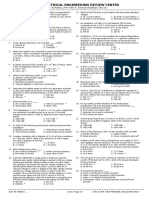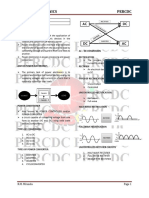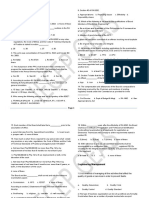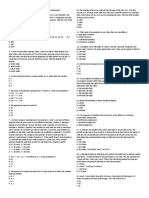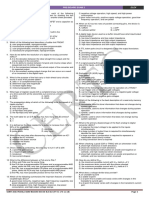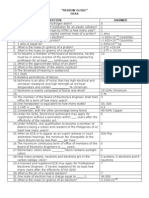Certcdavao: Instruction: Select The Correct Answer For Each of The Following
Certcdavao: Instruction: Select The Correct Answer For Each of The Following
Uploaded by
Jj JumawanCopyright:
Available Formats
Certcdavao: Instruction: Select The Correct Answer For Each of The Following
Certcdavao: Instruction: Select The Correct Answer For Each of The Following
Uploaded by
Jj JumawanOriginal Title
Copyright
Available Formats
Share this document
Did you find this document useful?
Is this content inappropriate?
Copyright:
Available Formats
Certcdavao: Instruction: Select The Correct Answer For Each of The Following
Certcdavao: Instruction: Select The Correct Answer For Each of The Following
Uploaded by
Jj JumawanCopyright:
Available Formats
CERTCDAVAO WEEKLY EXAM 8 Elecs
Electronic Engineering
Instruction: Select the correct answer for each of the following a. Av=gmRd c. Av=(g_m R_s)/(1+g_m R_s )*
questions. Mark only one answer for each item by shading the box b. Av=gmRs d. Av=(g_m R_d)/(1+g_m R_d )
corresponding to the letter of your choice on the answer sheet provided.
12. The capacitor that produces an ac ground is called a(n)
Strictly no erasures allowed. Use pencil no. 1 only.
a. coupling capacitor c. bypass capacitor*
NOTE: Whenever you come across a caret (^) sign, it means
b. dc open d. ac open
exponentiation.
1. Consider the following statements for a metal oxide semiconductor 13. In a class B push-pull amplifier, the transistors are biased slightly
field effect transistor above cutoff to avoid
(MOSFET): a. crossover distortion* c. negative feedback
P: As channel length reduces, OFF-state current increases. b. unusually high efficiency d. a low input impedance
Q: As channel length reduces, output resistance increases.
R: As channel length reduces, threshold voltage remains constant. 14. Three different points are shown on a dc load line. The upper point
S: As channel length reduces, ON current increases. represents the
Which of the above statements are INCORRECT? a. minimum current gain c. saturation point*
(A) P and Q (C) Q and R* b. quiescent point d. cutoff point
(B) P and S (D) R and S
15. Which of the following conditions are needed to properly bias an
2. The Ebers-Moll model of a BJT is valid npn transistor amplifier?
(A) only in active mode a. forward bias the base/emitter junction and reverse bias the
(B) only in active and saturation modes base/collector junction.
(C) only in active and cut-off modes b. forward bias the collector/base junction and reverse bias the
(D) in active, saturation and cut-off modes* emitter/base junction.
c. apply a positive voltage on the n-type material and a negative
3. A long-channel NMOS transistor is biased in the linear region with voltage on the p-type material.
𝑉𝐷𝑆=50 mV and is used as a resistance. Which one of the following d. apply a large voltage on the base.
statements is NOT correct?
(A) If the device width 𝑊 is increased, the resistance decreases. 16. Determine the gm of a source-follower network given IDSS=16mA,
(B) If the threshold voltage is reduced, the resistance decreases. Vp=4V, VGSQ=2.86V and IDQ=4.56mA.
(C) If the device length 𝑊 is increased, the resistance increases. a. 32.31ms b. 2.22ms c. 2.28ms* d. 3.22ms
(D) If 𝑊𝑊𝑊 is increased, the resistance increases.*
17. Determine the dynamic resistance of a voltage-divider Depletion
4. Which one of the following statements is correct about an ac- Type MOSFET with IDSS=6mA, Vp=-3. gos=10uS.
coupled common-emitter amplifieroperating in the mid-band region? a. 32.31ms b. 2.22ms c. 100k Ω* d. 231k Ω
(A) The device parasitic capacitances behave like open circuits,
whereas coupling and bypasscapacitances behave like short 18. If the value of resistor Rf in an averaging amplifier circuit is equal to
circuits.* the value of one input resistor divided by the number of inputs, the
(B) The device parasitic capacitances, coupling capacitances and output will be equal to
bypass capacitances behave likeopen circuits. a. the average of the individual inputs
(C) The device parasitic capacitances, coupling capacitances and b. the inverted sum of the individual inputs
bypass capacitances behave likeshort circuits. c. the sum of the individual inputs
(D) The device parasitic capacitances behave like short circuits, d. the inverted average of the individual inputs*
whereas coupling and bypasscapacitances behave like open
circuits. 19. If the input to a comparator is a sine wave, the output is a
a .ramp voltage c. rectangular wave*
5. A differential amplifier has an open-loop voltage gain of 120. The
b. sine wave d. sawtooth wave
input signals are 2.45V and 2.35V. Calculate the output voltage of
the amplifier. 20. To get a negative gate-source voltage in a self-biased JFET circuit,
A. 12 V * B. 14 V C. 16 V D. 10 V you must use a
a. voltage divider c. ground
6. A differential amplifier has an open-loop voltage gain of 150 and a b. source resistor* d. negative gate supply voltage
common input signal of 4.0 V to both terminals. An output signal of
15 mV results. Determine the common-mode gain and the CMRR. 21. In the constant-current region, how will the IDS change in an n-
A. 91.16 dB B. 89.76 dB C. 90.40 dB D. 92.04 dB * channel JFET?
a. as vgs decreases id decreases*
7. A good transimpedance amplifier has b. as vgs increases id increases
(a) Low input impedance and high output impedance c. as vgs decreases id remains constant
(b) High input impedance and high output impedance. d. as vgs increases id remains constant
(c) High input impedance and low output impedance
(d) Low input impedance and low output impedance* 22. IDSS can be defined as:
a. the minimum possible drain current
b. the maximum possible current with vgs held at –4 v
8. How many op-amps are required to implement this equation
c. the maximum possible current with vgs held at 0 v*
d. the maximum drain current with the source shorted
23. What is the input impedance of a common-gate configured JFET?
a. very low* c. high
A. 2 B. 3 C. 4 D. 1* b. low d. very high
9. In a CE germanium transistor amplifier, self-bias is used. The 24. With the E-MOSFET, when gate input voltage is zero, drain current
various parameters are: Vcc=16V, Rc=3k Ω, RE=2k Ω, R1=56k Ω, is:
R2=20k Ω and α=0.985. Determine the operating point. a. at saturation c. idss
b. zero* d. widening the channel
a.7.33V,1.88mA c. 3.22V, 1.55mA
b. 6.225V, 1.955mA* d. 7.87V, 1.623mA
25. With a 30-volt VDD, and an 8-kilohm drain resistor, what is the E-
10. 1The primary function of the bias circuit is to MOSFET Q point voltage, with ID = 3 mA?
a. hold the circuit stable at VCC a. 6 V* c. 24 V
b. hold the circuit stable at vin b. 10 V d. 30 V
d. hold the circuit stable at the designed Q-point*
26. When an input signal reduces the channel size, the process is
11. A source follower has a voltage gain (Av) of called:
CERTC Review Center : MANILA-CEBU-BAGUIO-DAVAO(09323288053) Page 1
CERTCDAVAO WEEKLY EXAM 8 Elecs
Electronic Engineering
a. enhancement c. gate charge b. integration or differentiation* d. addition or subtraction
b. substrate connecting d. depletion*
41. In an open-loop op-amp circuit, whenever the inverting input (–) is
27. In an n-channel JFET, what will happen at the pinch-off voltage? negative relative to the noninverting input (+), the output will:
a. the value of VDS at which further increases in VDS will cause a. swing negative c. be balanced
no further increase in ID* b. close the loop d. swing positive*
b. the value of VGS at which further decreases in VGS will cause
no further increases in ID 42. With a differential gain of 50,000 and a common-mode gain of 2,
c. the value of VDG at which further decreases in VDG will cause what is the common-mode rejection ratio?
no further increases in ID
a. –87.9 Db c. 43.9 dB
d. the value of VDS at which further increases in VGS will cause
b. –43.9 Db d. 87.9 dB*
no further increases in ID
43. The major difference between ground and virtual ground is that
28. The common-source JFET amplifier has:
virtual ground is only a:
a. a very high input impedance and a relatively low voltage gain*
b. a high input impedance and a very high voltage gain a. voltage reference* c. power reference
c. a high input impedance and a voltage gain less than 1 b. current reference d. difference reference
d. no voltage gain
44. If the gain of a closed-loop inverting amplifier is 3.9, with an input
29. The overall input capacitance of a dual-gate D-MOSFET is lower resistor value of 1.6 kilohms, what value of feedback resistor is
because the devices are usually connected: necessary?
a. in parallel c. with separate inputs a. 6240 ohms* c. 410 ohms
b. with separate insulation d. in series* b. 2.4 kilohms d. 0.62 kilohms
30. A field effect transistor operates with a drain current of 100 mA and 45. All of the following are basic op-amp input modes of operation
a gate source bias of −1 V. The device has agfs value of 0.25. If the EXCEPT
bias voltage decreases to−1.1 V, determine the change in drain a. inverting mode* c. double-ended
current b. common-mode d. single-ended
a.-7.8mA c. -25mA*
46. A circuit whose output is proportional to the difference between the
b. 25mA d. 7.8mA
input signals is considered to be which type of amplifier?
31. If the per unit value of electrons which leave the emitter and pass to a. common-mode c. differential*
the collector is 0.9 in an n-p-n transistor and the emitter current is 4 b. darlington d. operational
mA, then
47. If ground is applied to the (+) terminal of an inverting op-amp, the (–
a. the base current is approximately 4.4 mA
) terminal will:
b. the collector current is approximately 3.6 mA*
c the collector current is approximately 4.4 mA a. not need an input resistor c. have high reverse current
d. the base current is approximately 3.6 mA b. be virtual ground* d. not invert the signal
32. An ideal operational amplifier has 48. A noninverting closed-loop op-amp circuit generally has a gain
a. infinite output impedance c. infinite bandwidth* factor:
b. zero input impedance d. all of the above a. less than one c. of zero
b. greater than one* d. equal to one
33. Another name for a unity gain amplifier is:
a. difference amplifier c. single ended 49. If the Op – Amp in the figure has an input offset voltage of 5 mV and
b. comparator d. voltage follower* an open-loop voltage gain of 10,000 then V0 will be
34. A differential amplifier has a common-mode gain of 0.2 and a
common-mode rejection ratio of 3250. What would the output
voltage be if the single-ended input voltage was 7 mV rms?
a. 1.4 mV rms c.4.55 V rms*
b. 650 mV rmS d. 0.455 V rms A. 0 V C. + 15 V or -15 V*
B. 5 mV D. +50 V or -50 V
35. What is the difference between common-mode and differential-
mode input signals? 50. This circuit is an example of a(n)________.
a. phase relationship* c. current
b. voltage d. apparent power
36. The input offset current equals the
a. average of two base currents
b. collector current divided by the current gain
c. difference between two base-emitter voltages
d. difference between two base currents*
37. The common-mode voltage gain is A. dc voltmeter C. instrumentation amplifier*
a. smaller than differential voltage gain* B. display driver D. None of the above
b. equal to voltage gain
c. greater than differential voltage gain 51. Calculate the output voltage if V1 = –3.3 V and V2 = 0.8 V.
d. none of the above
38. An ideal amplifier should have:
a. high input current c. high output impedance
b. zero offset* d. moderate gain
39. If an op-amp has one input grounded and the other input has a
signal feed to it, then it is operating as what?
a. common-mode c. double-ended
b. single-ended* d. noninverting mode A. 0 V B. 6.6 V*
40. When a capacitor is used in place of a resistor in an op-amp C. –4 V D. 2 V
network, its placement determines:
a. open- or closed-loop gain c. saturation or cutoff
CERTC Review Center : MANILA-CEBU-BAGUIO-DAVAO(09323288053) Page 2
CERTCDAVAO WEEKLY EXAM 8 Elecs
Electronic Engineering
52. Determine the output voltage for this circuit with a sinusoidal input B. 16.7 mA D. 20 mA
of 2.5 mV.
A. –0.25 V 67. The principal advantage(s) of MOSFETs over BJTs is (are)
B. –0.125 V* A. their biasing networks are simpler.
C. 0.25 V B. their drive requirements are simpler.
D. 0.125 V C. they can be connected in parallel for added drive capability.
D. all of the above*
53. Whattype of biasing circuit is shown in the figure?
68. An op-amp integrator has a square-wave input. The output should
be
A. a sine wave. C. a triangle wave.*
B. a square wave. D. pure DC.
69. How many op amps does window comparator require?
A. 1 C. 2*
B. 3 D. 4
70. A transistor acts as __ when saturated.
A. open circuit C. variable resistance
A. Gate bias C. Gate feedback bias B. very low resistance* D. very high resistance
B. Self-bias* D. Emitter bias
71. For a fixed bias configuration, calculate the output impedance if
54. Which JFET amplifier would be used to couple a low-impedance RB=330kΩ, RC=2.7 kΩ, hfe=120, hie=1.175kΩ and hoe=20μA/V.
voltage source to a higher-impedance load? A. 1.171 kΩ C. 50 kΩ
A. The common-source amplifier C. The common-drain amplifier B. 2.56 kΩ* D. 2.7 kΩ
B. The common-gate amplifier* D. Depends upon the situation
72. An E-MOSFET with its gate connected to its drain is an example of
55. What is re′ equal to in terms of h parameters? A. A three-terminal device C. An active load*
A. hre / hoe* C. (hre + 1) / hoe B. A passive load D. A switching device
B. hie – (hre / hoe)(1 + hfe) D. hfe
73. Which of the following does not affect the junction capacitance of a
diode?
56. On the drain characteristic curve of a JFET for VGS = 0, the pinch-off A. the cross-sectional area of the P-N junction
voltage is B. the width of the depletion region
A. below the ohmic area. C. the phase of an applied ac signal*
B. between the ohmic area and the constant current area.* D. the reverse-bias voltage
C.between the constant current area and the breakdown region.
D. above the breakdown region. 74. In a P-channel JFET, the gate-source voltage must be connected so
that the positive polarity is applied to the _________terminal of the
JFET and the negative polarity is applied to the _______terminal.
57. A JFET data sheet specifies VGS(off) = –6 V and IDSS = 8 mA. Find the A. gate, source * C. drain, source
value of ID when VGS = –3 V. B. source, gate D. source, drain
A. 2 mA* C. 4 mA
B. 8 mA D. none of these 75. Determine the circuit shown in figure 13.
58. A class B amplifier operates in the linear region for
A. slightly more than 180° of the input cycle.
B. 360° of the input cycle.
C. slightly less than 180° of the input cycle.*
D. much less than 180° of the input cycle.
59. The IGBT has which three terminals?
A. anode, cathode, and gate C. emitter, collector, and gate*
B. source, drain, and gate D. emitter, collector, and base
60. A comparator with hysteresis is sometimes known as a(n)
A. integrator. C. differentiator.
B. Schmitt trigger.* D. none of the above
A. Voltage-divider bias IGFET
61. For an op-amp having a slew rate of 2 V/μs, what is the maximum B. Voltage-divider bias JFET
closed-loop voltage gain that can be used when the input signal C. Voltage-divider bias D-MOSFET
varies by 0.5 V in 10μs? D. Voltage-divider bias E-MOSFET*
A. 30 C. 40*
B. 50 D. 60 76. For a n-channel JFET with r0 = 10 kW, (VGS= 0 V, VP = - 6 V)the drain
62. The current gain of a pnp transistor is resistance rd at VGS= - 3 V is given by
A. the negative of the npn current gain A. 40 kΩ* B. 4.44 kW C. 2.5 kΩ D. 120 kW
B. the collector current divided by the emitter current
77. What does a voltage-divider bias provide?
C. near zero A. an unstable Q point
D. the ratio of collector current to base current* B. a stable Q point *
C. a Q point that is stable and easily varies with changes in the
63. An opamp comparator circuit employs transistor’s current gain
A. no feedback* C. -ve feedback D. a Q point that easily varies with changes in the transistor's current
B. +ve feedback D. both B and C gain
64. Which transistor bias circuit arrangement provides good Q-point 78. Referring to this transfer curve shown in figure 5, determine I D at VGS = 2
stability, but requires both positive and negative supply voltages? V.
A. base bias C. collector bias
B. voltage-divider bias D. emitter bias*
65. Which FET amplifier(s) has (have) a phase inversion between input
and output signals?
A. common-gate C. common-drain
B. common-source* D. all of the above
66. A class A amplifier with RC = 3.3 kΩ and RE = 1.2 kΩ has a VCC = 20
V. Find IC(sat)
A. 0.444 mA* C. 1.333 mA
A. 4.4 mA* C. 6.1 mA
B. 0.111 mA D. 4.444 mA
CERTC Review Center : MANILA-CEBU-BAGUIO-DAVAO(09323288053) Page 3
CERTCDAVAO WEEKLY EXAM 8 Elecs
Electronic Engineering
A. both the base-emitter and base-collector junctions are reverse
79. In figure 7, Calculate βdc at VCE = 15 V and IB = 30 μA. biased
B. the base-emitter junction is reverse biased, and the base-collector
junction is forward biased
C. the base-emitter junction is forward biased, and the base collector
junction is reverse biased
D. both the base-emitter and base-collector junctions are forward
biased*
92. Which biasing method is the most unstable?
A. Self bias C. Fixed bias *
B. Combination bias D. Emitter stabilized bias
93. The ______ stage provides a moderate voltage gain, a moderate input
impedance, and a moderate output impedance.
A. 100 B. 50 C. 116 D. 110* A. common-drain C. common-base
B. common-collector D. common-emmiter*
80. Introducing a resistor in the emitter of a common amplifier stabilizes the
dc operating point against variations in 94. For an n channel enhancement MOSFET with threshold voltage of 2.5
A. only the temperature C. only the β of the transistor V, determine the current at gate source voltage of 6 V.
B. both temperature and β* D. none of the above A. 0.675 mA C. 1.675 mA
B. 3.675 mA* D. 2.675 mA
81. Compared to a CE stage, a swamped amplifier has an input impedance
that is 95. Calculate the stability factor due to the variation of ICBO from 1 nA to 21
nA when the temperature changes from room temperature to 100 ˚C.
A. smaller B. equal C. larger* D. zero The change in collector-current due to the change of ICBO was found to
be 0.5 µA.
82. If βDC is increased by 10%, the collector-to-emitter voltage drop A. 5 C. 25*
A. increases by less than or equal to 10% B. 15 D. 35
B. decreases by less than or equal to 10%*
C. increase by more than 10% 96. If the capacitor from emitter to ground in a common emitter amplifier is
D. decreases by more than 10% removed, the voltage gain
A. increases C. decreases *
83. In a transistor amplifier, the reverse saturation current ICO
B. becomes erratic D. remains the same
A. double for every 10° rise in temperature*
B. doubles for every 1° rise in temperature
C. increase linearly with the temperature 97. What is true about the of a BJT?
D. doubles for every 5° rise in temperature A. lesser than 1* C. greater than 1
B. unity D. infinity
84. When the gate-to-source voltage (VGS) of a MOSFET with threshold
voltage of 400 mV, working in saturation is 900 mV, the drain current is 98. Why is the common – emitter amplifier the most widely used transistor
observed to be 1 mA. Neglecting the channel width modulation effect amplification configuration?
and assuming that the MOSFET is operating at saturation, what is the A. it provides voltage gain C. it provides high power gain
drain current for an applied VGS of 1400 mV? B. it provides current gain D. all of the above *
A. 0.5 mA B. 3.5 mA C. 2.0 mA D. 4.0 mA*
99. A JFET might work better than a bipolar transistor in
85. In the amplifier circuit shown in the figure, the values of R1 and R2 are
such that the transistor is operating at VCE = 3V and IC = 1.5 mA when
A. a high-voltage rectifier C. a weak-signal RF amplifier *
its â is 150. What is the operating point (VCE, IC) for a transistor with â B. a power-supply filter D. a power transformer
of 200.
100. An op-amp can be considered as an ideal
A. Voltage controlled current source
B. Current controlled current source
C. Voltage controlled voltage source *
D. Current controlled voltage source
GODBLESS AND MORE POWERS!
CERTC
A. 2V, 2mA* B. 4V, 2mA C. 3V, 2mA D. 4V, 1 mA
86. For normal operation of a pnp BJT, the base must be ___ with respect
to the emitter and ___ with respect to the collector.
A. positive, negative C. positive, positive
B. negative, positive* D. negative, negative
87. The current gain of a pnp transistor is
A. the negative of the npn current gain
B. the collector current divided by the emitter current
C. near zero
D. the ratio of collector current to base current*
88. The drain current of MOSFET in saturation is given by ID = K(VGS -
VT)2 where K is a constant. What is the magnitude of the
transconductance gm?
A. K(VGS - VT)2/VDS C. 2K(VGS - VT)*
B. ID/(VGS – VDS) D. K(VGS - VT)2/VGS
89. A common-emitter amplifier has (_____) voltage gain, (_____) current
gain, (_____) power gain, and (_____) input impedance.
A. high, low, high, low C. high, high, high, low*
B. high, high, high, high D. low, low, low, high
90. Which of the following is referred to as the reverse transfer voltage
ratio?
A. hi C. hr*
B. hf D. ho
91. A bipolar junction transistor (BJT) is used as a power control switch
by biasing it in the cut-off region (OFF state) or in the saturation region
(ON state). In the ON state, for the BJT
CERTC Review Center : MANILA-CEBU-BAGUIO-DAVAO(09323288053) Page 4
You might also like
- Masterguard C S Series FaultsDocument5 pagesMasterguard C S Series Faultsvayyik100% (1)
- 3Document4 pages3Arnel Pamaos Lopiba MontañezNo ratings yet
- IndiaBIX - Analog Electronics - Section 1Document6 pagesIndiaBIX - Analog Electronics - Section 1Mikaela VillalunaNo ratings yet
- Operating and Maintenance Manual Condensing Econ-CECDocument28 pagesOperating and Maintenance Manual Condensing Econ-CECJaime Zapata LopezNo ratings yet
- Electrical Engineering Practice ProblemsDocument4 pagesElectrical Engineering Practice ProblemsJj JumawanNo ratings yet
- CE ElexDocument4 pagesCE Elexjj012586No ratings yet
- WE2 EceDocument2 pagesWE2 EceJj JumawanNo ratings yet
- Crc-Plane TrigometryDocument8 pagesCrc-Plane TrigometryJevan A. CalaqueNo ratings yet
- WE1 EceDocument1 pageWE1 EceJj JumawanNo ratings yet
- Answer:: Y Abc + A + B + CDocument10 pagesAnswer:: Y Abc + A + B + CKarumon UtsumiNo ratings yet
- Certcdavao: Electronics EngineeringDocument4 pagesCertcdavao: Electronics EngineeringJj JumawanNo ratings yet
- Advance Review Weekly Exam 2 BacolodDocument4 pagesAdvance Review Weekly Exam 2 BacolodgiophilipNo ratings yet
- Power-Elex Notes 2022Document4 pagesPower-Elex Notes 2022Edwin Daniel RafananNo ratings yet
- Certc - Davao Diagnostic Exam: Instruction: Select The Correct Answer For Each of The FollowingDocument4 pagesCertc - Davao Diagnostic Exam: Instruction: Select The Correct Answer For Each of The FollowingJj JumawanNo ratings yet
- Day 01 - Algebra 1Document19 pagesDay 01 - Algebra 1Ironfalcon101No ratings yet
- DC Circuits GSDocument39 pagesDC Circuits GSRegine BuscaNo ratings yet
- Powerline Pre Board Ree Sept 2010Document15 pagesPowerline Pre Board Ree Sept 2010Junnar Jay AbañoNo ratings yet
- Transmission LinesDocument2 pagesTransmission LinesGlazylynCortezPalo100% (1)
- We 2Document2 pagesWe 2Jj JumawanNo ratings yet
- Percdc Cns Geas 1Document9 pagesPercdc Cns Geas 1Charles Adrian CNo ratings yet
- Draft of October 2015 Electronics Engineering Board Exam Questions and ConceptsDocument5 pagesDraft of October 2015 Electronics Engineering Board Exam Questions and ConceptsAyel Cejas Costiniano100% (1)
- Iecep Elecs 2Document10 pagesIecep Elecs 2Rick SarmientoNo ratings yet
- ExamDocument3 pagesExamMaria Deborah Vivas BaluranNo ratings yet
- MCQ in Geas by Perc DCDocument22 pagesMCQ in Geas by Perc DCAljonder LeycanoNo ratings yet
- ECS QuestionsDocument130 pagesECS Questionsjjmmnn1001100% (1)
- Algebra 1: Multiple ChoiceDocument1 pageAlgebra 1: Multiple ChoiceTrina Ritchell AquinoNo ratings yet
- VillamorDocument146 pagesVillamorEdbert CatapangNo ratings yet
- Certcdavao: Weekly Exam 1 EEDocument1 pageCertcdavao: Weekly Exam 1 EEJj JumawanNo ratings yet
- Math 1 AlgebraDocument4 pagesMath 1 AlgebraDaniel Fancis Amabran BarrientosNo ratings yet
- Aces Review Center: Ree Online Review Math Related Terms by Engr. Jimmy L. Ocampo 0920 - 644 - 6246Document5 pagesAces Review Center: Ree Online Review Math Related Terms by Engr. Jimmy L. Ocampo 0920 - 644 - 6246Jr TrinidadNo ratings yet
- Algebra PDFDocument12 pagesAlgebra PDFPaul Christian BondocNo ratings yet
- Geas IecepDocument32 pagesGeas IecepJenn BantilingNo ratings yet
- Basic Engineering Correlation ReviewerDocument30 pagesBasic Engineering Correlation Reviewerjaamartinez0% (1)
- TransmissionDocument8 pagesTransmissionMaria Deborah Vivas BaluranNo ratings yet
- Geas FinalDocument489 pagesGeas FinalroselleNo ratings yet
- Excel Geas 2 Coaching PDFDocument8 pagesExcel Geas 2 Coaching PDFTeena Marie SantosNo ratings yet
- Electronics MCQDocument4 pagesElectronics MCQHary KrizNo ratings yet
- Linx Review Center: Set ADocument11 pagesLinx Review Center: Set AWilssie SanchezNo ratings yet
- Integral CalculusDocument8 pagesIntegral CalculusDia Necson Nicole SapongNo ratings yet
- Advanced Math Problems No AnswerDocument6 pagesAdvanced Math Problems No Answermuelmar jan maraNo ratings yet
- GEAS Review GuideDocument15 pagesGEAS Review GuideSanny Domingo AfableNo ratings yet
- Pre Board Exam ElexDocument10 pagesPre Board Exam Elexart16marasiganNo ratings yet
- Batch 2 - Math 01 - Algebra 1 - ExercisesDocument1 pageBatch 2 - Math 01 - Algebra 1 - ExercisesJohn Anthony YumulNo ratings yet
- Signals and Systems - MCQ: B. SamplingDocument11 pagesSignals and Systems - MCQ: B. Samplingpavithra PNo ratings yet
- PERCDCDocument10 pagesPERCDCSheehan Kayne De CardoNo ratings yet
- Transmission MediasDocument3 pagesTransmission MediasCrissa Vin BabaanNo ratings yet
- ECE Materials and Components Section 1Document9 pagesECE Materials and Components Section 1MoneyNo ratings yet
- INDIABIXDocument7 pagesINDIABIXJanicz BalderamaNo ratings yet
- Beam Deflection Tables - MechaniCalcDocument8 pagesBeam Deflection Tables - MechaniCalcHAFIZNo ratings yet
- 2019 04 EeDocument7 pages2019 04 EeDatuali KanapiaNo ratings yet
- Coaching Geas 1Document144 pagesCoaching Geas 1Jhoe TangoNo ratings yet
- PE-AC-CIRCUITSDocument12 pagesPE-AC-CIRCUITSririkun2000No ratings yet
- Cmos QuestionsDocument10 pagesCmos Questionsmeenakshimani996No ratings yet
- FINAL EXAM EAFC 105 p2Document4 pagesFINAL EXAM EAFC 105 p2Ramil D TolentinoNo ratings yet
- ECE Mock Board Exam April 2022 ElectronicsDocument7 pagesECE Mock Board Exam April 2022 Electronicsx8t2w5ngjcNo ratings yet
- Ec 18Document11 pagesEc 18Darshan NakawalaNo ratings yet
- MME Electrical Session 1 Electrical FundamentalsDocument22 pagesMME Electrical Session 1 Electrical FundamentalsgpuonlineNo ratings yet
- ME1Document5 pagesME1jj012586No ratings yet
- ElectronicsDocument45 pagesElectronicsNorman OcoNo ratings yet
- Op AmpDocument3 pagesOp AmpAhnNo ratings yet
- GC-8 Basic ElectronicsDocument5 pagesGC-8 Basic ElectronicsyihesakNo ratings yet
- FLOYD2 32pagesDocument32 pagesFLOYD2 32pagesCorzynill MendozaNo ratings yet
- Certcdavao: Weekly Exam MathDocument2 pagesCertcdavao: Weekly Exam MathJj JumawanNo ratings yet
- Algebra 1 - Number Theory PDFDocument5 pagesAlgebra 1 - Number Theory PDFJj JumawanNo ratings yet
- MTE 506.curriculum and Instructional Materials DevelopmentDocument2 pagesMTE 506.curriculum and Instructional Materials DevelopmentJj JumawanNo ratings yet
- Certcdavao: Probability Trigonometry Plane Geometry Solid GeometryDocument1 pageCertcdavao: Probability Trigonometry Plane Geometry Solid GeometryJj JumawanNo ratings yet
- ElecDocument4 pagesElecJj JumawanNo ratings yet
- DE Ee1Document4 pagesDE Ee1Jj JumawanNo ratings yet
- DE Ee1Document4 pagesDE Ee1Jj JumawanNo ratings yet
- Exam DC1 and 2Document2 pagesExam DC1 and 2Jj Jumawan100% (1)
- Certcdavao: Instruction: Select The Correct Answer For Each of The FollowingDocument4 pagesCertcdavao: Instruction: Select The Correct Answer For Each of The FollowingJj JumawanNo ratings yet
- 10dc GeneratorDocument6 pages10dc GeneratorJj JumawanNo ratings yet
- MCQ Elex-BoylestadDocument216 pagesMCQ Elex-BoylestadJj JumawanNo ratings yet
- Model FP32A Guide en USDocument12 pagesModel FP32A Guide en USEmbyAnandaNo ratings yet
- Sharp TV Lc-40v7Document4 pagesSharp TV Lc-40v7Tim Tom100% (1)
- 2 Marks MPMC QB With AnswersDocument22 pages2 Marks MPMC QB With AnswerssridharparthipanNo ratings yet
- Resonant OcnverterDocument7 pagesResonant Ocnvertersatyam swarup dubeyNo ratings yet
- Advantys Telefast ABE 7 - ABE7CPA31EDocument5 pagesAdvantys Telefast ABE 7 - ABE7CPA31EArif M. SírioNo ratings yet
- Absolute DBDocument2 pagesAbsolute DBawa buayaNo ratings yet
- Datasheet 4029Document8 pagesDatasheet 4029Sarah RechNo ratings yet
- Frenic vg7sDocument50 pagesFrenic vg7sramon navaNo ratings yet
- Links of XII Physics Investigatory Project Allowtment 2Document3 pagesLinks of XII Physics Investigatory Project Allowtment 2yashtomarsoop07No ratings yet
- The Unijunction Transistor (UJT) - ThyristorsDocument6 pagesThe Unijunction Transistor (UJT) - Thyristorswww.vyeko_.bloger.hrNo ratings yet
- SPH0644LM4H-1 RevCDocument11 pagesSPH0644LM4H-1 RevCSSSANo ratings yet
- Deep Sea Electronics 053-027 Issue 4 Typical Wiring DiagramDocument2 pagesDeep Sea Electronics 053-027 Issue 4 Typical Wiring DiagramAttackDenied123No ratings yet
- Final: Total 200 Points, Duration: 12:15pm-3:15pm: EE 359 - Wireless Communications - Autumn 2016Document3 pagesFinal: Total 200 Points, Duration: 12:15pm-3:15pm: EE 359 - Wireless Communications - Autumn 2016Debajyoti DattaNo ratings yet
- Fluke 79 PDFDocument12 pagesFluke 79 PDFMiguel CarvajalNo ratings yet
- Stepper Motor DescriptionDocument19 pagesStepper Motor DescriptionKamal Ra JNo ratings yet
- MagnetronDocument17 pagesMagnetronMerry NunezNo ratings yet
- Week 07 Assignment 7Document23 pagesWeek 07 Assignment 7Deep GandhiNo ratings yet
- Lecture 3Document12 pagesLecture 3geofrey fungoNo ratings yet
- ESP32 I2C TutorialDocument16 pagesESP32 I2C TutorialpanikmanNo ratings yet
- Digital System Design (ELE-311) RCS (Makeup) (EngineeringDuniya - Com)Document1 pageDigital System Design (ELE-311) RCS (Makeup) (EngineeringDuniya - Com)Sudhakar JoshiNo ratings yet
- Pressure Transmitter: Type AKS 32 and AKS 33Document8 pagesPressure Transmitter: Type AKS 32 and AKS 33Miguel-Angel RuizNo ratings yet
- EN Tacho Harness DatasheetDocument4 pagesEN Tacho Harness DatasheetAlexDeLargeNo ratings yet
- UJT-Uni Junction Transistors: Construction of A UJTDocument9 pagesUJT-Uni Junction Transistors: Construction of A UJTRekhamtrNo ratings yet
- TSL25911 Datasheet EN v1 PDFDocument25 pagesTSL25911 Datasheet EN v1 PDFRjunix DejorasNo ratings yet
- Ds Ah 0079344Document2 pagesDs Ah 0079344Ursu AlexNo ratings yet
- IRFB4227Document8 pagesIRFB4227Fco. Jefferson Ferreira de SáNo ratings yet
- 42 Public Water Supply Grid Monitoring Using IoT and Avoid Underground Pipelines LeakageDocument3 pages42 Public Water Supply Grid Monitoring Using IoT and Avoid Underground Pipelines LeakagedileeppatraNo ratings yet
- TouchpadDocument4 pagesTouchpadHANIK PURWANINGSIHNo ratings yet

